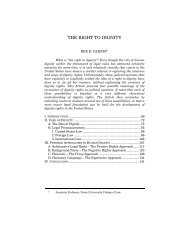A Right to Media? Lorie M. Graham - Columbia Law School
A Right to Media? Lorie M. Graham - Columbia Law School
A Right to Media? Lorie M. Graham - Columbia Law School
You also want an ePaper? Increase the reach of your titles
YUMPU automatically turns print PDFs into web optimized ePapers that Google loves.
488 COLUMBIA HUMAN RIGHTS LAW REVIEW [41:429<br />
media. In fact, funding remains a major obstacle for First Nations<br />
media. The Broadcasting Act recognizes that the Canadian<br />
broadcasting system should reflect the special place of Aboriginal<br />
peoples in Canadian society. However, the Act only requires that<br />
such programming should be provided “as resources become available<br />
for the purpose.” 229 This wording has been problematic for indigenous<br />
media because it makes funding unreliable and unpredictable, and<br />
links the availability of indigenous language broadcasting <strong>to</strong> the<br />
political process.<br />
Similar <strong>to</strong> the United States, Canada is well positioned, both<br />
in terms of law and policy, <strong>to</strong> advance and support a right <strong>to</strong> media<br />
under Article 16 of the UNDRIP. Canada has begun <strong>to</strong> develop laws<br />
that help <strong>to</strong> better ensure indigenous access <strong>to</strong> media through<br />
licensing, funding, and technical support. Lacking in this legislative<br />
scheme, however, is a clear articulation of the importance of media<br />
programming in indigenous languages. Such deficiencies can be<br />
rectified by placing indigenous languages on the same level as the<br />
other two official languages, thereby ensuring CRTC support and<br />
assistance for the development of cultural and linguistic media<br />
initiatives that will, in turn, support and strengthen indigenous<br />
media rights. Both an increase in development and improvement of<br />
telecommunication infrastructure is necessary <strong>to</strong> promote access and<br />
availability of media in remote parts of Canada.<br />
Finally, Canada’s his<strong>to</strong>ry demonstrates the particular<br />
devastation wrought by government-sponsored assimilationist<br />
policies and the subsequent erosion of languages. Even with funding<br />
and technology in place, the number of proficient indigenous<br />
language speakers able <strong>to</strong> work and consume indigenous media has<br />
been greatly diminished. <strong>Media</strong> is vital <strong>to</strong> cultural and linguistic<br />
survival, and language is necessary <strong>to</strong> the process of media<br />
production. The status-quo is a conundrum created by centuries of<br />
state-sponsored repression of indigenous cultures, one that poses<br />
tremendous challenges <strong>to</strong> Canada’s First Nations. By supporting<br />
indigenous media rights through additional public or state-run<br />
initiatives, Canada can work <strong>to</strong> reverse some of the intergenerational<br />
harms with respect <strong>to</strong> indigenous language and culture. Similarly,<br />
such support can assist in countering stereotypes found in nonindigenous<br />
media sec<strong>to</strong>rs. Finally, the economic and social<br />
development of First Nations, as well as their participation in the<br />
229. Broadcasting Act, 1991 S.C., ch. 11 (Can.) § 3(1)(o).















